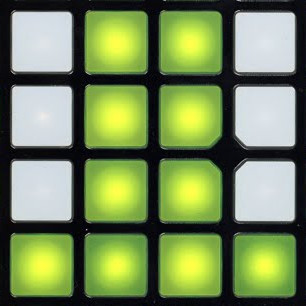Difference between revisions of "256a-fall-2014/hw3"
From CCRMA Wiki
| Line 1: | Line 1: | ||
| − | = Homework #3: AudioVisual Music Sequencer = | + | = Homework #3: AudioVisual Music Sequencer Thing = |
<div style="text-align: left;">[[Image:Sequencer-thing.jpg]]</div> | <div style="text-align: left;">[[Image:Sequencer-thing.jpg]]</div> | ||
| Line 10: | Line 10: | ||
* part C (demo/mini-performance)) due: 2014.11.03, in-class Wednesday | * part C (demo/mini-performance)) due: 2014.11.03, in-class Wednesday | ||
| − | Almost inevitably at some point in one's music software design journey, you'll be asked/tempted to make a step sequencer. In this assignment, we are going to get that off our chest/out of our system, and make a crazy, real-time, audio-visual step sequencer! | + | Almost inevitably at some point in one's music software design journey, you'll be asked/tempted to make a step sequencer. In this assignment, we are going to get that off our chest/out of our system, and make a crazy, real-time, audio-visual step sequencer like thing! |
| Line 26: | Line 26: | ||
** can you save/load sequences? what file format? should we have a common Music256a/476a format?! | ** can you save/load sequences? what file format? should we have a common Music256a/476a format?! | ||
** how to control/depict tempo? | ** how to control/depict tempo? | ||
| − | * sketch as much as detail as possible, even if you don't end implementing them! | + | * sketch as much as detail as possible, even if you don't end up implementing them! |
| − | * be ready to | + | * be ready to hand in design on paper (or send me, imdone256@gmail.com, digital scans if you have them) and be ready to present on Monday! (scans of these design sketches can go onto your website for this project!) |
Latest revision as of 16:35, 14 October 2015
Contents
Homework #3: AudioVisual Music Sequencer Thing
NOTE from Ge: this image is here mostly for its colors, PLEASE DON'T MAKE IT LOOK LIKE THIS (NECESSARILY)!
- part A (research + on-paper design) due: 2014.10.20, in-class Monday (be prepared to present)
- part B (implementation) due: 2014.10.30 11:59:59pm, Thursday.
- part C (demo/mini-performance)) due: 2014.11.03, in-class Wednesday
Almost inevitably at some point in one's music software design journey, you'll be asked/tempted to make a step sequencer. In this assignment, we are going to get that off our chest/out of our system, and make a crazy, real-time, audio-visual step sequencer like thing!
(Part 1 of 3): Research + Preliminary Design + Specs
- due in-class Monday (10/20)
- do research on music sequencers!
- compile a list of useful references on various types of step sequencers / designs (articles, papers, images, etc.)
- sketch your own preliminary design of a real-time audio-visual step sequencer!
- what features to include?
- what does it look like? linear? circular? spherical? mobius?!?
- sequencing of pitch? dynamics (loundness)? envelopes (attack/decay/sustain/release)?
- how many parallel tracks / layers / or different types of sound? (e.g., track 1 synth, track 2 drum etc)
- how input the sequence (in real-time)?
- how does it sound? will it use synthesis? load audio samples? soundfonts? MIDI?
- can you save/load sequences? what file format? should we have a common Music256a/476a format?!
- how to control/depict tempo?
- sketch as much as detail as possible, even if you don't end up implementing them!
- be ready to hand in design on paper (or send me, imdone256@gmail.com, digital scans if you have them) and be ready to present on Monday! (scans of these design sketches can go onto your website for this project!)
(Part 2 of 3): Implementation
- due 2014.10.30 11:59:59pm, Thursday
- decide on a design + set of features for an real-time audio-visual step sequencer; the design decisions should account for the questions raised in part 1 above!
- implement a working prototype of your step sequencer
- welcome (but don't have) to use:
- MCD-API
- libsndfile for audio file loading (will need to install library)
- STK (synthesis toolkit)
- potential things to sequence:
- pitch
- dynamics
- different timbre's / instruments
- envelopes
- "hints"
- think of user/interaction design **and** software/system design
- create an audio engine, as well as a graphics engine; how do they interact?
- create a webpage for your audiovisual sequencer, which must contain:
- one or more screenshot(s)
- your initial design sketches + research, motivate and articulate how you made your design decisions
- system design: how is your software architected? recommend a class diagram!
- downloading the code
- (for part 3: stuff from part 3 below)
(Part 3 of 3): Musical Statement + In-Class Presentation
- due: 2014.11.03, in-class Monday
- using your sequencer, create a short musical statement;
- either make a video of you performing it, and/or a short recording (mp3)!
- present your step sequencer and music instrument in class!
Note
- as always, have fun with it!!! make it P.S.!!!
- comment your code!
- choose your own coding conventions - but be consistent
- you are welcome to work together, but you must do/turn in your own work (you'll likely get more out of it this way)
Deliverables
turn in all files by creating a new CCRMA webpage: http://ccrma.stanford.edu/~YOURID/256a/hw3/
- 0) source code to the project (*.h, *.cpp, *.c makefile, etc.)
- 1) screenshots of your step sequencer in action
- 2) design sketches (scan them in if necessary)
- 3) your musical statement!
- 4) instructions on building the project (for example, anyone in the class should be able to download
- 5) instructions in using your step sequencer
email URL to imdone256 and ge!
